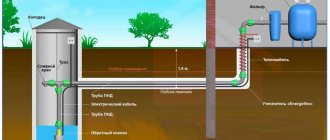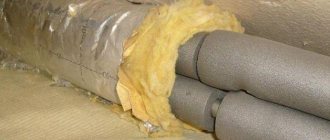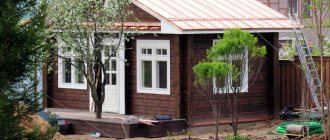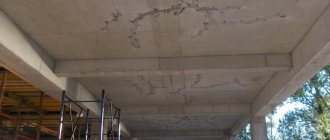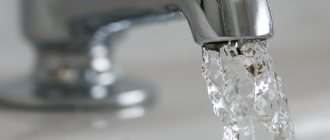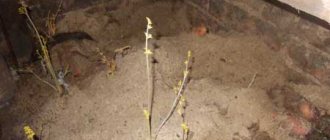Basements are a traditionally significant part of the house in Russia. The large area of the underground part of the house allows you to locate technical rooms there (laundry, workshop or even a home theater) or storage for household supplies. Separately equipped cellars also act as storage facilities.
In both winter and summer, it is very convenient to have free access to a cool, dark room with a uniform temperature, but then spring comes, the groundwater level rises, and not every basement or cellar remains dry. Quite often, leaks of varying sizes occur, their consequences also vary - from the appearance of dampness to complete flooding - but the results of this disaster are always the same: the basement can no longer be used, and serious damage to supplies and property is caused.
Even slight dampness in the basement is already a disaster. In a damp microclimate, mold and mildew actively develop, which harm people’s health, spoil things, and have a destructive effect on the floor and walls of the room.
Meanwhile, all of these problems could be avoided by properly sealing the basement to protect it from water. However, even after a flooded basement, not all is lost: it can be drained and repaired, and it will serve for many years to come.
Why does water appear in the basement?
The main and most dangerous source of water entering the basement is groundwater.
To protect against them, a drainage system is provided at the construction stage, and if the groundwater level is high or rises strongly in the spring, the house is built on a foundation made of a monolithic reinforced concrete slab. Therefore, it is so important to find out about the level of groundwater at the stage of design and construction of a house.

Another source is surface water from precipitation (rain, melted snow). To protect buildings from them, trenches are dug along the perimeter below the base of the basement, and pipes are laid in them to drain water. The structure is designed with a slight slope.
However, when the soil becomes saturated with moisture, the pressure increases, and this water begins to seep into the pores and cracks that are always present in concrete.
The absence or violation of the waterproofing system of the underground part of the structure is another of the main reasons for flooding and dampness in the basement.
Important!
Concrete is a very durable material, but it necessarily contains pores and capillaries into which water can enter. To increase water resistance, plasticizers and water repellents are added to concrete mixtures.
We advise you to study: Plasticizers for concrete
Even ordinary water is considered an aggressive liquid in relation to concrete: in the pores and cracks, after water enters, microorganisms (mold, bacteria) begin to multiply, the metabolic products of which destroy the concrete, and when freezing in winter, the water expands, and new microcracks appear in the concrete.

But groundwater is not just water, but, in fact, a solution of salts and acids, because in most regions of our country the soils are acidic to one degree or another.
Interesting!
If you live in an area with a lot of coniferous trees, the soil is probably acidic.
Solutions of salts and acids destroy concrete even faster than pure water. Small cracks become larger and larger, the material begins to crumble and loses its quality.
Flooding can also be caused by water or sewer pipes. Plumbing is not a force of nature; Eliminating and preventing pipe leaks is easier than dealing with groundwater.
Important!
It is necessary to take care of reliable drainage, ventilation and waterproofing of the basement at the stage of design and construction of the house. But it happens that a house is purchased or inherited ready-made. In this case, knowledge of how to get rid of water in the basement and waterproof the basement from groundwater from the inside will be useful.
Sequence of waterproofing work
If water enters quickly, the coating will not have time to set and will be squeezed out by the pressure. It is necessary to make a hole in the wall, insert a tube through which water will flow out, and cover the surface with an insulating film. When the composition has set, the tube is pulled out and the hole is sealed with a hydraulic seal. The substance hardens in 10 seconds. There is no need to delay application. There is no need to dilute too much solution.
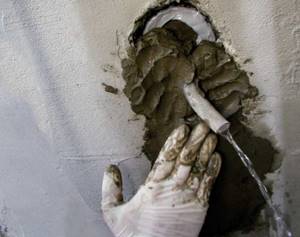
You can lower your blood pressure
How to isolate a basement from groundwater. Basement protection methods
To protect your home and basement from flooding, you need to provide high-quality waterproofing.
Today, there are three main methods of waterproofing a basement from groundwater:
- Anti-pressure. It is so called because it resists the pressure of water from the outside. This waterproofing is done on the outside of the building. It is usually recommended to do this if the groundwater level is higher than the floor level in the basement or cellar.
- Non-pressure. Protects mainly from rain and melt water. Recommended in case of deeper groundwater (lower than the basement floor).
- Anticapillary. This is protection against water penetration into cracks and capillaries in concrete, brick and other porous building materials. The traditional method is the use of bituminous materials, but there is a more modern and effective solution - the use of penetrating compounds. They are applied generously in one or several layers. Such compositions penetrate the pores and capillaries of concrete and cover it with a waterproof thin film that protects it from water.
Based on the method of performing the work, waterproofing can be divided into external and internal.
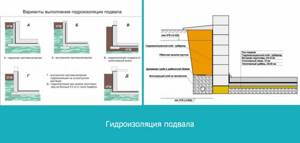
External waterproofing is carried out from the outside, which means that before starting work it is necessary to remove all the soil around the perimeter and clean the walls of dirt, and only after that begin waterproofing work:
- large cracks and crevices are sealed with cement-sand mortar;
- the walls are coated with bitumen mastic, onto which roll materials are glued;
- instead of bitumen, you can use penetrating compounds that are applied with a brush or roller in one or several layers;
- The materials dry within two days.
Important!
The waterproofing system should include waterproofing the foundation slab or basement floor.
Such protection works for 40–50 years, protecting the house from water penetration.
Internal waterproofing
This method of waterproofing allows you to renovate your basement with less labor; it is suitable if flooding has already occurred and the external waterproofing system has failed.
Important!
Waterproofing the basement from the inside works as part of a set of measures, including drainage and ventilation.
In this case, modern materials such as the cement-based dry mixture WaterPlug CEMMIX are suitable for reliable sealing of active leaks.

This mixture is diluted with cold water to obtain a plastic mass from which a filling can be made.
A distinctive feature of the WaterPlug mixture is its ability to harden quickly, which makes it suitable for repair work with active leaks.
Materials for emergency sealing of leaks
Sometimes it becomes necessary to fix leaks in the basement walls instantly to avoid flooding. For this purpose, cement-based products are used with an instant hardening time of about 10 seconds from the beginning of contact with water.
One of the most popular means of such action is considered to be the Gambit hydroseal. The manufacturer guarantees long-term water resistance of the product even under adverse climatic conditions.
The methods of working with the protective agent are simple, but have their own specific features:
- The leaking surface must be cleaned of various separating layers in the form of oils, greases, weak layers of plaster, dust and dirt.
- Application is done with a hand wearing a smooth glove: the dry hydroseal mixture is compressed in a handful until it is as compact as possible and immediately pressed into the leak hole until the water stops completely.
- If the pressure is significant, you should first quickly mix the composition in water to a thick paste and plug the hole with the resulting lump with a strong fixation.
- The manufacturer has provided the possibility of simplifying the work by using nylon containers up to 2 cm wide and a maximum length of 20 cm. The container is removed from the sealed packaging, moistened, crimped and fixed in a crack or leaking seam.
- After eliminating the leak, additional strengthening and sealing of the seam or crack is carried out using special compounds from the same manufacturer, which are offered to the buyer separately.
- Upon completion of work, you must immediately wash the tool and any possible contaminants in the water.
- Material is purchased at a calculated consumption rate of 1.5 kg per dm2.
Other manufacturers produce similar products for eliminating pressure leaks, the principle of operation of which is similar.
Universal Cleaner
Moss and mold cleaner for walls, floors and roofs (concentrate)
Read more
In addition, it has the following advantages:
- works underwater;
- hardening time - from 1.5 to 5 minutes;
- has high adhesion to various materials;
- can be used for both external and internal work;
- it is environmentally friendly, which means it can be used without a doubt in private homes, in basements intended for storing food;
- vapor permeable;
- waterproof;
- frost-resistant;
- durable;
- economical;
- allows operation in the temperature range from +5°C to +30°C.
WaterPlug CEMMIX dry mix is easy to purchase in retail stores, for example, the Leroy Merlin chain or wholesale from the manufacturer.
Materials and tools necessary for waterproofing the basement from groundwater from the inside
Proper waterproofing is carried out on the side of exposure to an aggressive environment (water) to protect building materials from destruction as a result of getting wet.
But it is not always possible to dig out walls, and especially floors, under a building, which is why technologies for waterproofing rooms from the inside have been developed.
To do this, you will need waterproofing materials, for example, Universal, which is mixed with water before work, after which the entire surface of the walls and floors is coated with it.
Important requirements for the surface before application: no moving cracks in the structure. If there are any, they must be insulated with ClearFixa elastic material.
In the case of particularly critical structures, pressure walls and an additional layer of concrete on the floor are installed to the waterproofing layer. Such a system is called a “pinched” or, in accordance with accepted construction terminology, a “sandwich system.”
Tools that will be useful are a mixing container and spatulas for applying the mixture, as well as personal protective equipment (gloves, goggles, respirator).
Ditch, seal, waterproof
Our user with the nickname ALEXUS_81 has constant water in the basement because “a goblin brigade of monolithic workers poured screed onto the floor without any waterproofing or reinforcement.” Because the floor is unprotected, he doesn't see the point in digging out the basement and applying waterproofing to uneven surfaces. All the water has already been pumped out by the pump, but where it comes from is not visible, so the plan to combat basement flooding is as follows:
- To groove and seal all joints between concrete walls and floors;
- Treat all basement walls and floors with penetrating insulation so that there is no more “capillary action.”
ALEXUS_81FORUMHOUSE Member
If all the cracks are caulked and the capillary movement of water is stopped, then there should be no water flow into the basement. Although one unsealed hole may be enough for flooding.
This is what the underground garage of our user with the nickname Magma looked like before the basement was waterproofed:
Water penetrated into the basement through the capillaries of the concrete and through the junction of the floor and the wall. We had to make grooves to dump water into a drainage well with a pump. Water began to flow quite actively from the opened seams, the pump worked in continuous mode. To stop the water, we first had to make hydraulic seals, and then seal the grooves with joint compound. At the last stage, the concrete surface was treated with a penetrating compound.

This is the result that we managed to obtain.
How to make internal waterproofing of basement walls. Step-by-step instruction
Let's look at the basic steps of arranging basement waterproofing.
Step 1: Removing water

If the basement is flooded with water, then at the first stage the water is removed by manually scooping it out or pumping it out using a pump.
Step 2. Drying
The room needs to be dried. The capillary flow of water through the structures is stopped by rubbing the WaterPlug dry mixture manually in a circular motion until the flow of moisture stops.
Step 3. Filling the floor
In a basement after flooding, it is often advisable to re-flood the floor. The old base is cleaned of dirt and loosely bound particles and treated with Universal waterproofing mixture, then a concrete screed is made. To ensure a strong and high-quality screed, the way the concrete mixture is prepared is of great importance.
It is possible to lay the mixture well without special equipment if it has a flexible consistency, but such a consistency is usually associated with excess water content, which ultimately does not have the best effect on the strength of concrete.

Adding a plasticizer to the mixture allows you to save up to 15% of cement, do without excess water and at the same time obtain a mobile, self-laying mixture and strong, dense concrete. For a basement, it is especially important that the concrete be dense, with a small number and small diameter of pores. Such concrete is less prone to getting wet. The plasticizer allows you to reduce the number and diameter of pores in concrete and obtain a dense, water-resistant screed.
Also, at the screed manufacturing stage, it is advisable to use water-repellent additives and impregnations for concrete, which give them water-repellent properties.
We advise you to study: Water repellents for concrete
Step 4: Treating the Basement Walls
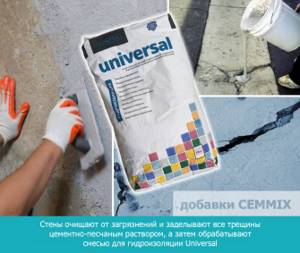
The walls are cleaned of dirt and all cracks are sealed with cement-sand mortar, and then treated with Universal waterproofing mixture or special waterproofing impregnations.
Important!
What to do if you find water in the basement of a private house? For emergency repairs, use seals made from the dry mixture WaterPlug CEMMIX, which allows repairs even during a leak, even under water. A hydraulic seal made from a dry mixture is, in fact, also concrete, but not simple, but waterproofing. Therefore, it can be used not only in places of active leakage, but also where the possibility of its occurrence is expected.
Penetrating waterproofing
The so-called penetrating basement waterproofing is one of the most effective methods of protection. Penetrating mixtures are made on the basis of high-strength cements, supplemented with special components that penetrate into the micropores of concrete at least 60 centimeters, crystallizing there upon contact with moisture and creating a barrier to water for a long time.
Such waterproofing of the basement ceiling will ensure dryness in the house, and applying penetrating compounds to the base of the floor and walls will protect the room from leaks, high humidity and the occurrence of microorganisms. Waterproofing is carried out, most often, inside the basement, using a wide brush. In this case, a prerequisite is good moistening of the structure before processing.
Universal Cleaner
Moss and mold cleaner for walls, floors and roofs (concentrate)
Read more
How to protect your basement from dampness:
- During new construction, do not be lazy to carry out reconnaissance work to find out the depth of groundwater. Design a quality drainage system, basement ventilation, and waterproofing.
- If the house is not new, and groundwater lies close to the surface, install a drainage system around the perimeter and carry out external and internal waterproofing work.
- If you are not sure where the leak is coming from, apply a coating of Universal waterproofing mixture to the entire doubtful area.
- If water appears in the basement, the dry mixture WaterPlug CEMMIX and Universal waterproofing mixture, which have proven themselves well with various materials, will help to urgently eliminate the leak.
Tips for using WaterPlug CEMMIX dry mix:
- If there is an active leak in a large area, make a dovetail cutout, place a seal in it and press it down with a block. after this the flow will stop.
- If there are several sources of leakage, start treating from the top of the wall, gradually moving down.
- WaterPlug CEMMIX can also be used underwater. You'll plug the leak and then deal with the problem of draining and then waterproofing the basement.
If the basement or cellar leaks, this is not a reason to stop using it. Using modern materials, you can quickly eliminate leaks or overhaul your basement and continue to use it, saving money on the construction of a new basement. Water repellents and dry mixtures WaterPlug and Universal from CEMMIX will help you make high-quality and reliable repairs.
You can buy WaterPlug CEMMIX without leaving your home, with discounts from 5 to 33%!!!!
Buy on Ozon
Buy on VseInstrumenty.ru

Buy on Wildberries
Buy at Leroy Merlin
Or you can find the nearest official dealer in your region on our map

← How to use waterproof silicone and polyurethane sealants
Cladding of buildings: why do you need brick on the facade →
Return to list
Comments
Anti-capillary waterproofing
Anti-capillary waterproofing of the basement is done to prevent moisture from rising along the walls of the foundation and rooms located below the ground surface. Such measures protect the structure from deformation and subsequent destruction. Several years ago, to carry out similar manipulations, roofing felt or bitumen was used to treat the base of the foundation. Today, a more popular method is penetrating waterproofing, which allows you to protect the basement structure from moisture.
News
We are always ready to help
Cemmix has opened a free hotline
to help you with any questions related to construction using concrete additives. Call and ask, our consultants are always ready to help!
Hyperplasticizer
Hyperplasticizers are a new type of plasticizing additives for concrete, ensuring the mobility of the mixture above P5. In addition to plasticity, they increase the water resistance and frost resistance of concrete by 2-3 times.



